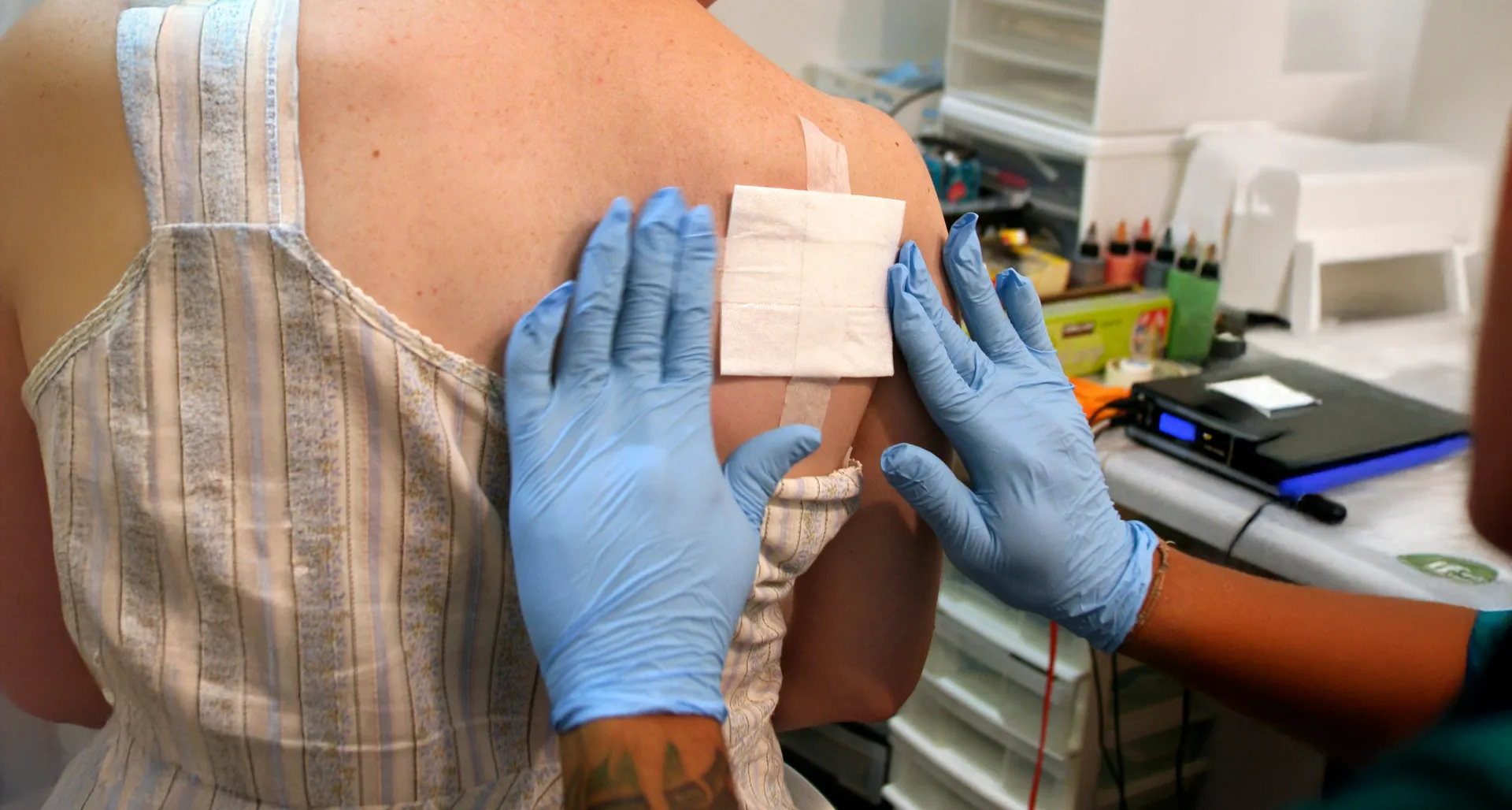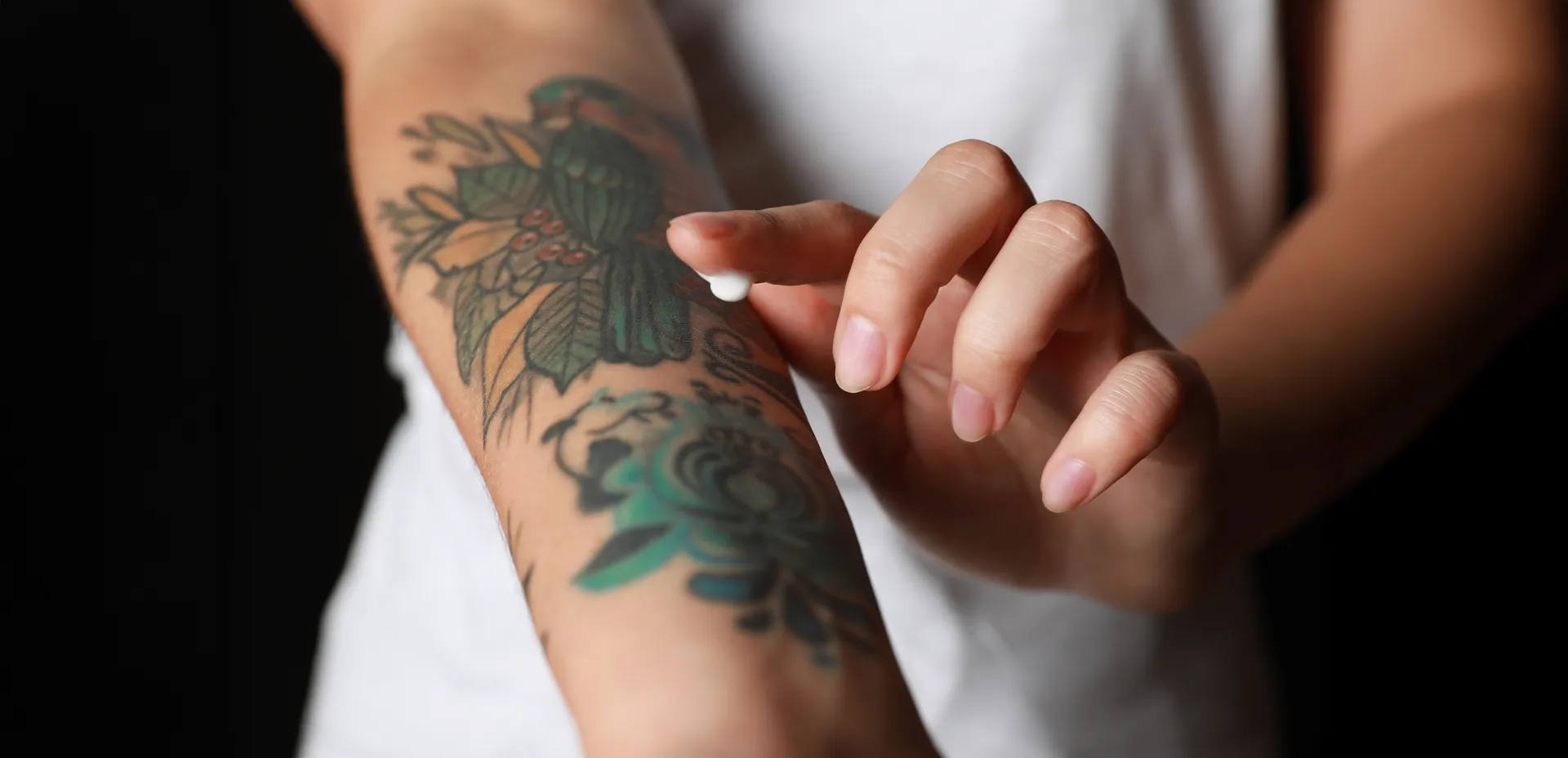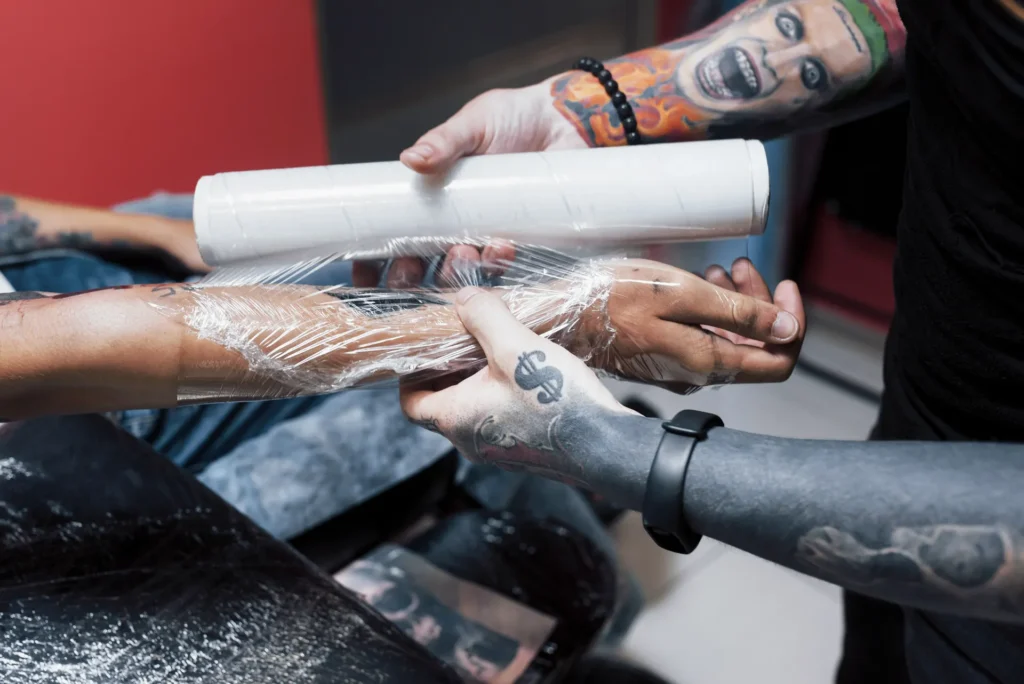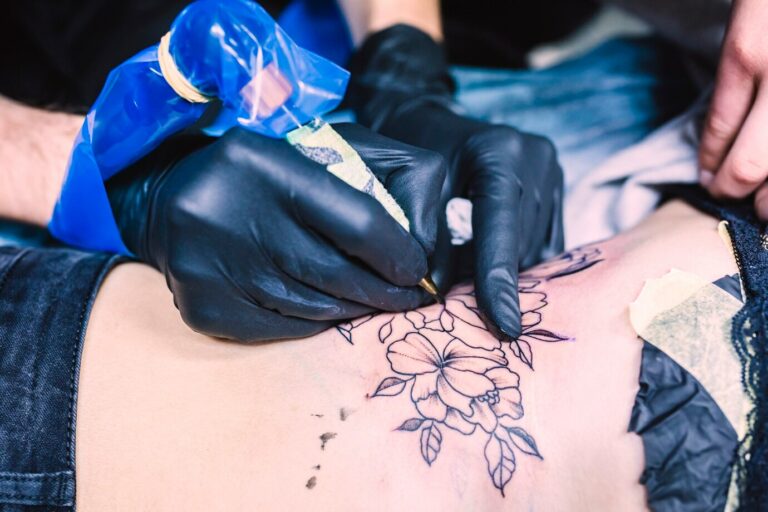Proper tattoo aftercare is crucial for both healing and maintaining the longevity of your ink. Following this comprehensive “Tattoo Aftercare Guide: How to Keep Your Ink Looking Fresh,” ensures that your tattoo heals correctly, minimizing the risk of complications such as infections or scarring.
Proper care impacts tattoo vibrancy and prevents complications:
- Healing: Proper aftercare supports the body’s natural healing process, reducing the chances of infection and promoting faster recovery.
- Vibrancy: By keeping the tattoo moisturized and protected from harmful elements like UV rays, you help preserve its color and sharpness.
- Complications: Inadequate care can lead to issues such as fading, ink loss, or even more severe complications like infections.
Engaging in proper tattoo aftercare not only keeps your tattoo looking fresh but also ensures it remains a beautiful part of your body art collection for years to come.
Understanding Tattoo Healing
Tattooing involves puncturing the skin with needles to deposit ink into the dermis. This controlled trauma signals your body to begin a natural healing process, which unfolds in specific tattoo healing stages.
What Happens During Healing:
- Immediate Response: The immune system sends white blood cells to fight off bacteria and start repairing tissue. Swelling, redness, and oozing of plasma are normal during the first day or two.
- Scabbing and Peeling: A thin layer of scabs forms as part of skin regeneration. These scabs act as protective barriers over the inked area. As days pass, mild itching and flaking typically begin — signs your skin is regenerating new cells underneath.
- Restoration: After about two weeks, most surface healing is complete, but deeper layers of skin may still be mending. The tattoo might appear slightly dull or cloudy until full recovery.
Typical Timeline for Tattoo Healing:
- Days 1–3: Initial inflammation, oozing, and tenderness.
- Days 4–14: Formation of scabs, peeling, and ongoing itchiness.
- Weeks 2–6: Scabs fall off naturally; color clarity increases as inner layers heal.
Why You Shouldn’t Disturb Scabs:
Picking or scratching at scabs disrupts the delicate healing process. Interfering can pull out ink with the scab, leading to patchy color loss or permanent scarring. Allowing scabs and flakes to detach naturally preserves both the health of your skin and the vibrancy of your tattoo.
Understanding these stages helps you support proper skin regeneration and avoid complications linked to poor aftercare.
Immediate Aftercare Steps
Immediate tattoo care starts the moment your artist finishes the last line. The fresh tattoo is essentially an open wound, making the first few hours and days critical for proper healing.
Initial Bandaging and Plastic Wrap
- Artists usually cover new tattoos with sterile bandages or plastic wrap to protect against bacteria, dirt, and friction.
- Keeping this covering on for the recommended time — often a few hours — minimizes infection risk and locks out contaminants from entering the skin.
Washing New Tattoos
- After removing the initial covering, gently wash your tattoo using lukewarm water and a mild, fragrance-free soap. Harsh soaps or scrubbing can damage delicate skin and ink.
- Use your clean hands to lightly cleanse the area; avoid washcloths, loofahs, or anything abrasive.
Drying and Moisturizing Tattoos
- Pat dry with a soft, clean towel or allow to air dry. Rubbing can pull at scabs or disrupt healing tissue.
- Apply a thin layer of fragrance-free moisturizer immediately after drying. Specialized products like King Tattoo Butter or Aquaphor are widely used for their gentle, hydrating properties.
- Avoid heavy application. Too much ointment can suffocate the skin and prolong healing.
This routine — gentle washing, careful drying, and light moisturizing — forms the foundation of immediate tattoo care. Each step helps lock in color while protecting against infection and irritation.
Protecting Your Tattoo During Healing
Tattoo protection during healing ensures the fresh ink stays vibrant and infection-free. The first few weeks are critical — how you treat your tattoo now directly influences its long-term appearance.
1. Avoid Sunlight on New Tattoos
Direct UV exposure can irritate sensitive skin and break down pigments, leading to premature fading. Shelter your tattoo from the sun by staying indoors when possible or covering it with clothing. If you must be outside, keep the area completely shielded until fully healed. Sunscreen should only be used after your artist confirms the tattoo is healed, as applying it too early may cause irritation.
2. Skip Pools, Baths, and Hot Tubs
Submerging a healing tattoo introduces bacteria and chemicals that greatly increase infection risk. Showers are safe; soaking is not. Chlorine, salt water, and even prolonged bathwater exposure can compromise both healing and color retention.
3. Choose Clothing for Healing Tattoos
Friction is a common culprit behind faded lines and patchy healing. Opt for loose-fitting, breathable fabrics that won’t stick to or rub against your tattoo. Tight gear can trap sweat and bacteria, while synthetic materials might not allow the skin to breathe adequately.
“Healing tattoos need space to breathe and minimal disturbance — think soft cotton shirts instead of leggings or tight sleeves,” say many artists in their aftercare instructions.
Sticking closely to these tips from any reputable “Tattoo Aftercare Guide: How to Keep Your Ink Looking Fresh” will help minimize complications while maximizing your tattoo’s longevity.
Long-Term Tattoo Care for Vibrancy
To keep your tattoo looking vibrant for years to come, it’s important to practice consistent long-term care. Here are some key practices to follow:
1. Use High SPF Sunscreen
Protecting your healed tattoo from the sun is crucial. UV rays can cause significant fading and damage to the ink. Applying a high SPF sunscreen specifically designed for tattoos helps shield against these harmful effects. Look for products that offer broad-spectrum protection and are water-resistant to ensure maximum defense.
2. Continue Moisturizing
Keeping your skin hydrated is vital for maintaining the vibrancy of your tattoo. Dry skin can lead to flaking and dullness, which affects the appearance of the ink. Use a fragrance-free moisturizer or a specialized product like Hustle Butter Deluxe to keep the skin supple and healthy. Regular moisturizing helps preserve the tattoo’s color and detail, making it look fresh even years after getting inked.
By incorporating these practices into your routine, you ensure that your tattoo remains as striking as the day you got it. Prioritizing sunscreen and moisturizer will keep your ink looking its best over time, allowing you to enjoy your body art without worry.
Common Mistakes to Avoid in Tattoo Aftercare
Tattoo aftercare mistakes can significantly impact the healing process and the longevity of your tattoo. Here are some common pitfalls to avoid:
1. Using Harmful Products
Avoid products containing alcohol, fragrances, or harsh chemicals. These substances can irritate the sensitive skin around your tattoo, potentially leading to dryness, redness, and delayed healing. Stick to mild, fragrance-free soaps and specialized tattoo aftercare products like King Tattoo Butter or Aquaphor.
2. Ignoring Signs of Infection
It’s crucial to recognize signs of infection early to prevent complications. Symptoms such as redness, swelling, pus, or increased pain around the tattooed area indicate a potential infection. If you notice any of these signs, seek medical advice promptly to ensure proper treatment.
3. Scratching or Picking Scabs
The formation of scabs is a natural part of the healing process. However, scratching or picking at these scabs can cause scarring and color loss. This behavior is often linked to skin-picking disorder, which can be difficult to manage. It’s essential to resist the urge and allow scabs to fall off naturally to maintain the integrity of your tattoo.
4. Exposing a Tattoo to Water
During the healing phase, avoid soaking your tattoo in water by staying away from swimming pools, hot tubs, and baths. Prolonged exposure to water can increase the risk of infection and hinder the healing process.
5. Direct Sunlight Exposure
Protect your healing tattoo from direct sunlight, as it can cause irritation and fading. Once healed, continue using high SPF sunscreen to preserve the vibrancy of your ink.
By being mindful of these common mistakes and following proper aftercare guidelines, you can ensure that your tattoo heals well and remains vibrant for years to come.
Tips from Tattoo Artists on Aftercare
Professional tattoo artists play a crucial role in post-ink care. Their guidance is based on years of hands-on experience and firsthand observation of what actually works for different skin types and tattoo styles. You’ll notice that most reputable artists provide both verbal instructions at the end of each session and written aftercare guides tailored to your specific tattoo placement, size, and individual skin needs.
What you can expect from expert aftercare advice:
- Personalized Instructions: Artists assess the complexity of your design, its location, and your skin type before advising. For example, tattoos on joints or areas prone to friction might receive special cleaning or moisturizing guidelines.
- Written Resources: Many studios hand out printed aftercare sheets or direct you to their websites for a detailed tattoo aftercare guide and how to keep your ink looking fresh.
- Product Recommendations: Experienced professionals often suggest tried-and-tested products such as:
- Aquaphor Healing Ointment: Trusted for its gentle, non-irritating formula.
- King Tattoo Butter: Popular among artists for all-natural ingredients that soothe freshly tattooed skin.
- Fragrance-free moisturizers: Brands like Aveeno or Eucerin are staples for sensitive healing areas.
- Ongoing Support: Many artists encourage follow-up visits or offer digital check-ins if you have questions or concerns during the healing process.
In addition to professional advice, incorporating elements such as succulents into your living space can also promote a calming environment during the healing process. Relying on professional tattoo aftercare advice ensures you’re not just guessing — you’re benefiting from proven routines developed through countless healed tattoos.
Conclusion
Consistent care routines are essential for successful healing and the lasting beauty of your tattoos. By following the steps outlined in this guide, you can ensure that your ink remains vibrant and fresh over time.
- Immediate Aftercare: Keep your tattoo clean and moisturized to promote proper healing.
- Protection During Healing: Avoid direct sunlight, swimming pools, and tight clothing to prevent irritation.
- Long-Term Care: Use high SPF sunscreen and continue moisturizing to maintain the vibrancy of your tattoo.
Effective tattoo aftercare is crucial for preventing complications and ensuring that your tattoo looks its best for years to come. By adhering to these guidelines, you can enjoy a beautiful, well-healed tattoo that stands the test of time.
Remember, consistency in your aftercare routine will make all the difference. Your commitment to proper aftercare is the key to keeping your ink looking fresh and vibrant.





